Animals
Our Animals
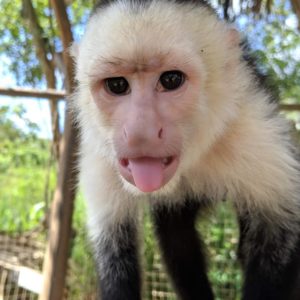
Characteristics, Housing, Diet and other information
Characteristics
White-faced capuchins have distinctive markings that distinguish them from other capuchin monkeys. They have a black body with a white upper chest and shoulders, and a white face with a black cap on top of their head which is said to give these monkeys their name as it resembles the hood of capuchin.
The capuchin is considered to be the most intelligent New World monkey.
It is a long-lived monkey, with a maximum recorded age of over 54 years. Panamanian white-faced capuchins are highly social, living in groups of 16 individuals on average, about three quarters of which are females.
These monkeys are omnivores, so they eat both meat and plants. They eat nuts and fruits such as figs and mangoes. Leaves, insects, lizards, and birds are also on the menu.
Housing
The white-faced capuchin is found in much of Central America. In Central America, its range includes much of Honduras, Nicaragua, Costa Rica and Panama. It has also been reported to occur in eastern Guatemala and southern Belize, but these reports are unconfirmed. It is among the most commonly seen monkeys in Central America.
While the white-faced capuchin is very common in Costa Rica and Panama, the monkey has been largely extirpated from Honduras and much of Nicaragua. Many Honduran capuchins were captured and relocated to the island of Roatán, and many Nicaraguan capuchins were captured and relocated to the island of Ometepe. In Nicaragua, wild capuchins may still be easily spotted in regions around Masaya, as well as around Bluefields and other locations around the South Caribbean coast. They are seen, in the wild, daily by visitors who climb one of the volcanoes on Ometepe Island.
It is found in many different types of forest, including mature and secondary forests, and including evergreen and deciduous forests, dry and moist forests, and mangrove and montane forests. However, it appears to prefer primary or advanced secondary forests. Also, higher densities of white-faced capuchins are found in older areas of forest and in areas containing evergreen forest, as well as areas with more water availability during the dry season.
Diet
They are fed three times a day, these monkeys are omnivores, so they eat both meat and plants. They eat nuts and fruits such as figs and mangoes. Leaves, insects, lizards, and birds are also on the menu. In addition, they sometimes eat tree rats such as the Speckled spiny tree-rat.
Scientists have observed that these white-headed monkeys are willing to try to eat a variety of foods – even an unfamiliar fruit or an insect they’ve never seen before. In short, these monkeys will try to eat anything they find in their habitat.
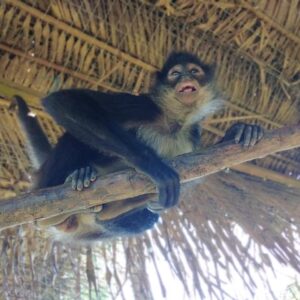
Characteristics, Housing, Diet and other information
Characteristics
Spider monkeys form loose groups, typically with 15 to 25 individuals, but sometimes up to 30 or 40. During the day, groups break up into subgroups. The size of subgroups and the degree to which they avoid each other during the day depends on food competition and the risk of predation. The average subgroup size is between 2 and 8 but can sometimes be up to 17 animals. Also less common in primates, females rather than males disperse at puberty to join new groups. Males tend to stick together for their whole lives. Hence, males in a group are more likely to be related and have closer bonds than females. The strongest social bonds are formed between females and their young offspring.
Spider monkeys communicate their intentions and observations using postures and stances, such as postures of sexual receptivity and of attack. When a spider monkey sees a human approaching, it barks loudly similar to a dog. When a monkey is approached, it climbs to the end of the branch it is on and shakes it vigorously to scare away the possible threat. It shakes the branches with its feet, hands, or a combination while hanging from its tail. It may also scratch its limbs or body with various parts of its hands and feet. Seated monkeys may sway and make noise. Males and occasionally adult females growl menacingly at the approach of a human. If the pursuer continues to advance, the monkeys often break off live or dead tree limbs weighing up to 4 kilograms (8.8 lb) and drop them towards the intruder.
Diet
The diets of spider monkeys consist of about 70 to 85 percent of fruits and nuts. They can live for long periods on only one or two kinds of fruits and nuts. They eat the fruits of many big forest trees, and because they swallow fruits whole, the seeds are eventually excreted and fertilized by the feces. Studies show the diet of spider monkeys changes their reproductive, social, and physical behavioral patterns. Most feeding happens from dawn to 10 am. Afterward, the adults rest while the young play. Through the rest of the day, they may feed infrequently until around 10 pm. If food is scarce, they may eat insects, leaves, bird eggs, bark and honey.
Spider monkeys have a unique way of getting food: a lead female is generally responsible for finding food sources. If she cannot find enough food for the group, it splits into smaller groups that forage separately. The traveling groups have four to nine animals. Each group is closely associated with its territory. If the group is big, it spreads out.
Reproduction
The female chooses a male from her group for mating. Both males and females use “anogenital sniffing” to check their mates for readiness for copulation. The gestation period ranges from 226 to 232 days. Each female bears only one offspring on average, every three to four years.
Until six to ten months of age, infants rely completely on their mothers. Males are not involved in raising the offspring.
A mother carries her infant around her belly for the first month after birth. After this, she carries it on her lower back. The infant wraps its tail around its mother’s and tightly grabs her midsection. Mothers are very protective of their young and are generally attentive mothers. They have been seen grabbing their young and putting them on their backs for protection and to help them navigate from tree to tree. They help the more independent young to cross by pulling branches closer together. Mothers also groom their young.
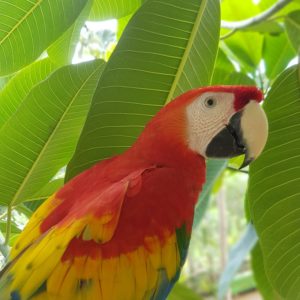
Characteristics, Housing, Diet and other information
Characteristics
The scarlet macaw is the national bird of Honduras, a large and majestic creature easily recognizable by its lively red, blue and yellow coat. But the species’ magnificence has helped contribute to its demise in the wild, Scarlet macaws are important seed predators of large tree fruits in the ecosystems in which they live. They may influence the generation of forest tree species, Studies have concluded that Scarlet Macaws have the intelligence to distinguish colors and shapes. with the right trainer, some of these birds can even perform simple math problems. Scarlet Macaws are said to have the intelligence of a 4-8 year old child with the emotional intelligence of a 2 year old
They can live up to 55 years in the wild and 95 years in captivity.
Care
Macaws are the largest of the parrots. A scarlet macaw is best suited for a large space and will not thrive in a cage that is too small. Get a cage that is at least 2 1/2 feet by 3 feet. It needs a lot of out-of-cage time, and if it doesn’t get it, the bird may develop behavioral problems. It will resort to feather-plucking and other forms of self-mutilation. They can get bored quite easily, so provide them with large swings and toys.
Once a week, offer your macaw a bath or hose down your bird with lukewarm water using the fine-mist setting of your handheld shower sprayer.
To prevent your bird from flying through an open window or door, trim its primary wing feathers.
Diet
Nuts, leaves, berries, and seeds from the rainforest make up the bulk of the scarlet macaw’s diet. Its strong, hooked beak is perfect for breaking nuts and seeds.
The best diet for a macaw in captivity begins with a formulated parrot mix that includes a variety of seeds, dried fruits, and nuts. Provide a variety of fresh fruits and vegetables daily, as well as high-calcium greens like kale and spinach. An all-seed diet is extremely unhealthy for these birds. Never offer chocolate and avocado, which are toxic.
The average healthy macaw will consume approximately 10 to 15 percent of its body weight daily. An average bird weighs about 2 pounds. You can expect a bird will eat about 1/2 cup of food per day, which equates to about 100 pounds of food per year. Feed them in the morning upon waking. Remove any uneaten chop or freshly cut fruits and vegetables after an hour.
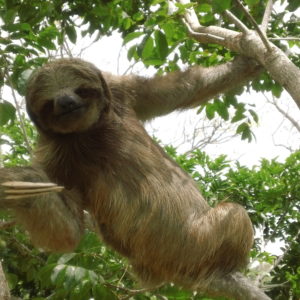
Characteristics, Housing, Diet and other information
Characteristics
Sloths spend most of their lives upside down, and their bodies are highly adapted to this lifestyle. They have long limbs with curved claws, which enable them to hang from branches. They even have adaptations that fix their internal organs in place with adhesions preventing pressure on their lungs. The sloth’s nature allows it to conserve energy, moving slower than any other mammal on the planet. This modest pace means that sloths generally travel no more than 125 feet (38 meters) in a single day, and on the rare occasion that they find themselves at ground level, they crawl only 1 foot (30 cm) per minute.
Fun Sloth Facts for Kids
Sloths are a medium-sized mammal.
All sloths actually have three toes, but the two-toed sloth has only two fingers.
Sloths are part of the order Pilosa so they are related to anteaters and armadillos.
Sloths are tree-dwelling animals, they are found in the jungles of Central and South America.
Housing
In the wild, sloths spend all their time in tall trees. In captivity, they need plenty of trees or structures to spend their day hanging from. They are not able to walk on the ground since they have claws at the ends of their arms and legs and no hands or feet. They will drag their legs if moving along the ground. Keep them in a secured area for their protection from other pets and people.
Position climbing logs, poles, branches for climbing within reach of each other. Sloths do not jump from tree to tree like lemurs and monkeys.
A sloth’s natural habitat is the rainforests of Central and South America where it is very hot and very humid. In captivity, they need this same kind of humidity and temperature. A habitat can be difficult to replicate if you do not provide a small enclosed room (at least 8-feet cube) that allows you to control the environment. People use heaters and humidifiers to recreate a tropical atmosphere of about 90 to 100 Fahrenheit with 80 to 90% humidity. Sloths that remain too cold for too long will experience a drop in body temperature, and their digestive system will shut down. You can take your sloth out of its makeshift rainforest-like room for short periods, but it must go back to its room to sleep.
Diet
One of the hardest parts of owning an exotic pet like a sloth is trying to replicate its natural diet in captivity. Sloths eat leaves, mainly leaves found on the trees of Central and South America.
They sleep about 20 hours a day and usually forage for food at night. Their metabolism is so slow that it can take up to three weeks or one m
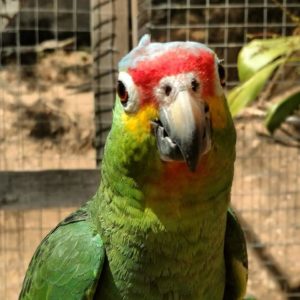
Characteristics, Caring, Diet and Nutrition
Characteristics
The double yellow-headed Amazon parrot, or yellow-headed parrot, is among the most popular companion Amazons, probably due to its striking coloring and its ability to amass a substantial vocabulary. These birds are especially talented in learning opera and other types of singing, making them charming companions.
LIFESPAN. The average lifespan of the Yellow-Headed Amazon is 20 to 30 years in the wild and 60 to 80 in captivity. We all know that the biggest pride of all the Amazons is their great ability to talk, sing and mimic. It should not come as a surprise when your pet develops a substantial vocabulary or displays its great arsenal of memorized melodies and common sounds. They are certain to be at the center of attention, showing off their mimics in a goofy voice. They also have loud and often harsh natural calls, but these are usually heard only twice a day in short periods. Still, an Amazon parrot is best kept as a house pet, to avoid noise complaints.
Caring
Yellow-headed Amazon parrots are best suited for experienced bird owners. They require a great deal of attention, and you will need to set aside a period each day for one-on-one interaction with your bird. This socialization is key to establishing and maintaining a healthy bond.
These birds thrive on social interaction, and they need it to remain healthy and happy. Neglected birds can fall into destructive behavior patterns and depression. Depression or anxiety can lead to physical and emotional problems, including feather plucking and biting people.
For these reasons, you should ask about the history of any mature bird you’re looking to adopt. Bad habits, past trauma, and inadequate training can result in a parrot that even the best bird behaviorists will have difficulty rehabilitating.
Potential owners should remember that if they adopt a yellow-headed Amazon, they are taking on the care of a creature that is every bit as intelligent and emotional as a human toddler. Due to their very long lifespan, caring for one is not a commitment to be taken lightly.
Make sure you provide a cage that is suited to this bird—at least 3-foot-square. The bird may seem small, but it still needs room to move and play. Keep the bird occupied while you’re not available by outfitting the cage with ladders, perches, and interactive toys.
Diet and Nutrition
Amazon parrots eat a variety of seeds, nuts, fruits, berries, and vegetation in the wild.
Like all Amazon parrots, yellow-headed Amazons are prone to obesity in captivity. Obesity can not only take years off a bird’s life but also lead to tumors and other serious health issues. Provide your bird a healthy diet, limit high-fat foods like seeds and nuts, give your bird daily exercise. A mentally stimulating activity for your bird is hiding an occasional treat, which mimics the bird’s instinct to forage for its food.
Yellow-headed Amazons do best on a high-quality pelleted diet supplemented with seed mix. Daily servings of fresh bird-safe fruits and vegetables will also ensure that your bird is getting the right balance of the vitamins and nutrients it needs. Feed approximately 1/3 to 1/2
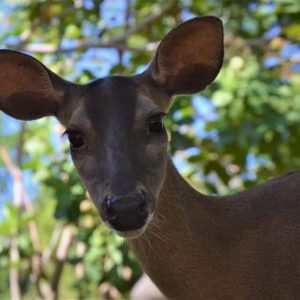
Characteristics, Breeding, Diet and Behavior
Characteristics
White-tailed deer, the smallest members of the North American deer family, are found from southern Canada to South America. In the heat of summer they typically inhabit fields and meadows using clumps of broad-leaved and coniferous forests for shade. During the winter they generally keep to forests, preferring coniferous stands that provide shelter from the harsh elements.
Whitetail deer have an enormously diverse diet, and can eat more than 600 species of plants. They prefer acorns, grasses, leaves, crops like soybeans and corn, berries, twigs, fungi, fruit, and nuts to eat. They have four chambered stomach, which can digest extremely tough vegetation.
The yucatan white-tailed deer is Honduras’ national mammal and the national symbol of all Honduran wildlife about 6 years.
Most male white-tailed deer live to about 6 years of age. Some live longer, some less. Females tend to live about two years longer than males.
Breeding
Adult white-tails have reddish-brown coats in summer which fade to a duller grayish-brown in winter. Male deer, called bucks, are easily recognizable in the summer and fall by their prominent set of antlers, which are grown annually and fall off in the winter. Only the bucks grow antlers, which bear a number of tines, or sharp points. During the mating season, also called the rut, bucks fight over territory by using their antlers in sparring matches.
Diet and Behavior
White-tailed deer are herbivores, leisurely grazing on most available plant foods. Their stomachs allow them to digest a varied diet, including leaves, twigs, fruits and nuts, grass, corn, alfalfa, and even lichens and other fungi. Occasionally venturing out in the daylight hours, white-tailed deer are primarily nocturnal or crepuscular, browsing mainly at dawn and dusk.
In the wild, white-tails, particularly the young, are preyed upon by bobcats, mountain lions, and coyotes. They use speed and agility to outrun predators, sprinting up to 30 miles per hour and leaping as high as 10 feet and as far as 30 feet in a single bound.
Although previously depleted by unrestricted hunting in the United States, strict game-management measures have helped restore the white-tailed deer population.
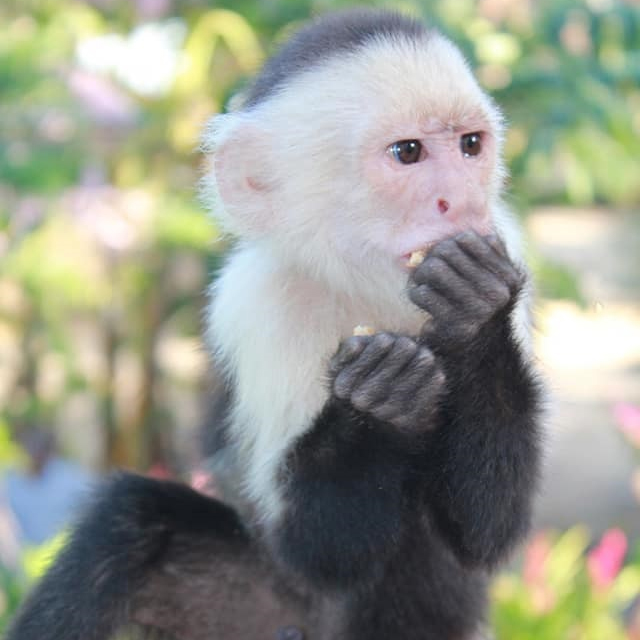
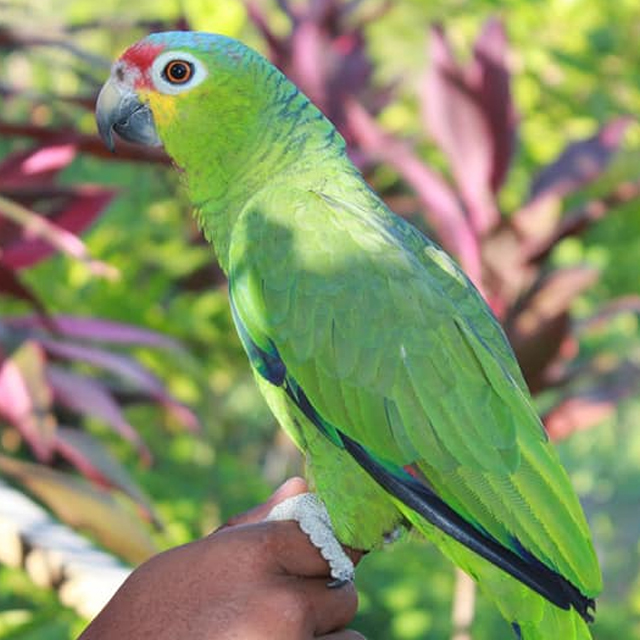

wellbeing of our animals
If you would like to contribute with the wellbeing of our animals, you can make a donation to our paypal account. Every little bit helps.
